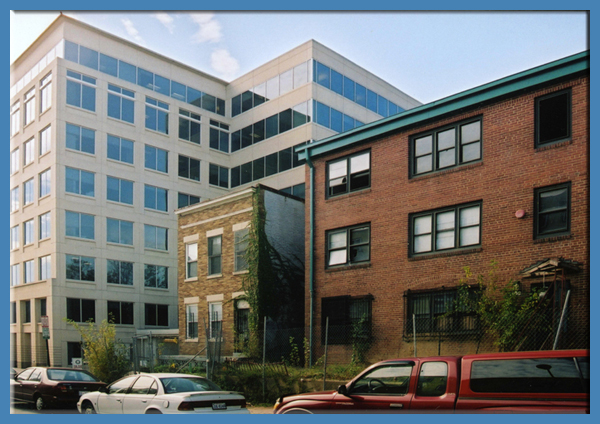In the mid-1950s, a government "redevelopment agency" sent waves of bulldozers against Washington's Southwest quadrant as if they were Patton's tank corps. In the end, more than 5,000 buildings vanished and the city had sustained psychic wounds that are still unhealed.
Was Southwest redevelopment a tragedy? It's true that some bulldozed houses lacked indoor plumbing even in the late 1950s. Yet at the same time, long-established African-American neighborhoods were obliterated and their residents scattered in the name of "eradicating slums", creating resentments that persist two generations later. Was this indeed a case of "saving" a community by destroying it?
On Old Southwest's streets it will always be Saturday morning, with early sunshine bringing out the reddest tints in the brick facades of well-kept modest rowhouses and cutting deep shadows across their windows. Even though the photographer was up early, there is already a small knot of children outside a corner grocery, weighing the merits of baseball cards versus a Hershey bar. Beside one cast-iron stoop the sun warms the seats of a couple of folding chairs for the arrival of some neighborhood philosophers. Fifty years later, it is clear that the neighborhoods which survive only on fading color slides comprised much more than "slums" and "squalor".
Today redevelopment on the same scale is taking place on the opposite side of South Capitol Street. "Near Southeast" stretches along South Capitol from the Southeast Freeway to the Anacostia River. Long a backwater of transit garages, cab lots, and body shops, as well as low-rise public housing, sand and gravel yards, and short strings of nineteenth century rowhouses, the old sections of Near Southeast are quickly being swept clear by a combination of public and private interests. The highest profile project is of course the Washington Nationals Stadium, whose footprint will cover several square blocks near the Anacostia. The associated "Ballpark District" development will replace much of what stands south of M Street SE, while the neighborhood between M Street and the SE Freeway is already redeveloping as high-rise office and hotel space.
While it is hard to grieve at the replacement of utilitarian truck garages or vacant lots turned taxicab boneyards, their redevelopment means that Washington loses much of its scant industrial flavor. Along with the unmourned 1950s warehouses or 1970s gas stations, worthy buildings are being swept away, including the last survivors of gritty nineteenth century neighborhoods of railroad workers and Naval Gun Factory laborers.
As a memorial to what was, good or ugly as it may have been, the following pages present a photo-tour of Near Southeast as it existed in 2004-2006. Our tour begins at the top of this page, where the 1100 block of Fourth Street SE shows the three faces of Near Southeast. Beside a gleaming office tower, a derelict Arthur Capper Homes public housing unit flanks the type of row house it was built to replace but will not survive.
Our tour next splits into four paths:
Click here for our retrospective feature "JUST DON'T CALL THEM SENATORS" from 2004.
Click here to tour the "The Stadium Site"
Click here to visit the Stadium Site's lost neighbors in "The Ballpark District"
Coming Soon: A North End Tour

